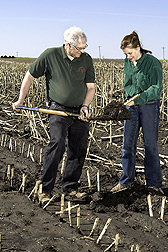This page has been archived and is being provided for reference purposes only. The page is no longer being updated, and therefore, links on the page may be invalid.
Read the magazine story to find out more. |
|
|
Protecting Soils and Producing Biofuel with Corn Stover
By Ann PerryOctober 27, 2008
Those lonely cornstalks—called corn stover—left behind in the fields after the grain harvest is complete could someday become valuable raw material for the production of cellulosic ethanol. In the meantime, Agricultural Research Service (ARS) soil scientist Doug Karlen is determining which portion of the plant would work best for cellulosic ethanol production. He's also studying the amount of stover that needs to remain in the fields to prevent soil erosion and recycle essential plant nutrients.
Karlen works at the ARS National Soil Tilth Laboratory in Ames, Iowa. He partnered with a research team that harvested cornstalks at four different heights to quantify the amount and quality of stover that could be obtained using different removal strategies.
The team also evaluated several aspects of harvesting stover for ethanol production. These factors included engineering challenges associated with harvesting, how stover removal could potentially impact future crop production and soil quality, and how potential ethanol production might vary with harvest methods.
As part of the study, stover yields from the four harvest groups were converted to ethanol using biochemical processing. The researchers measured the resulting net energy yield and decided that the most likely factor driving conversion efficiency was the level of moisture in the feedstock.
After evaluating harvest convenience and speed, acceptable stover water content and other factors, the researchers concluded that a "normal cut" harvest would result in the most economical and efficient stover harvest for biofuel production. When the "normal cut" stover was harvested, at least 16 inches of stubble remained on the field.
Karlen's research is part of a larger national effort to evaluate the environmental and economic costs and benefits that might accrue from large-scale corn stover removal for cellulosic ethanol production. This project—the Renewable Energy Assessment Project, or REAP—supports corn producers who want to optimize sustainable practices that maximize production, reduce costs and protect natural resources.
Read more about this research in the October 2008 issue of Agricultural Research magazine.
ARS is a scientific research agency of the U.S. Department of Agriculture.

